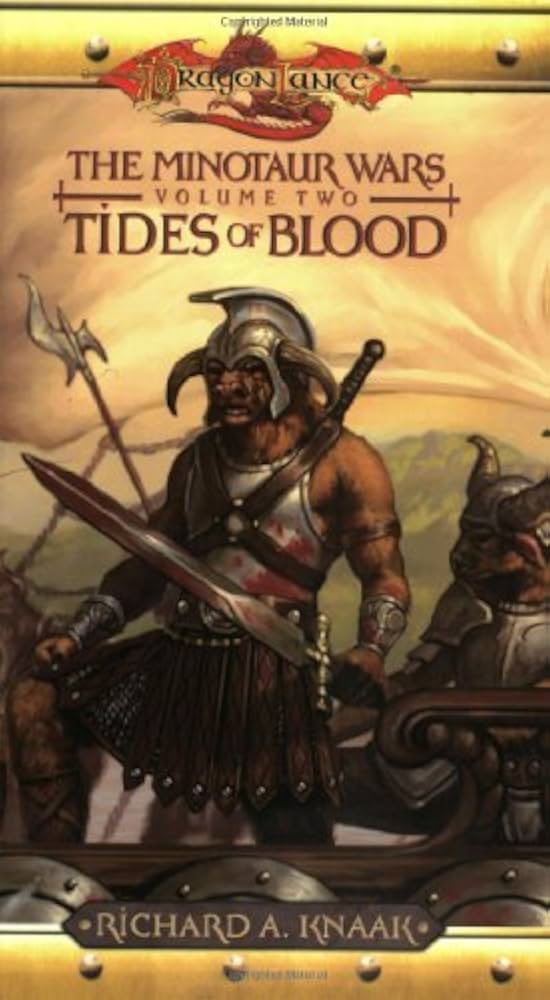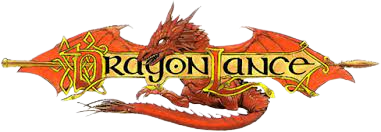Tides of Blood

Table of Contents
ToggleOverview
Tides of Blood is the second book in the Minotaur Wars Trilogy of the Dragonlance universe. It chronicles the further rise of Hotak de-Droka as he extends his empire across the seas, carrying out a campaign of domination, religious fervor, and militaristic conquest. This middle installment deepens the themes of tyranny, divine manipulation, and resistance, setting the stage for the empire’s eventual reckoning in Empire of Blood.
This is a story of escalation—from civil war to imperial expansion—and the consequences of power claimed in the name of the gods.
Main Character: Hotak de-Droka
Now Emperor, Hotak leads a holy war across Taladas and beyond, believing himself the divine hand of Sargas.
His transformation from reformer to imperial zealot is nearly complete, with his authority unquestioned and his ruthlessness unmatched.
He believes that Sargas’ will is fulfilled only through conquest and blood, and his military campaigns reflect that philosophy.
Cracks begin to show in his leadership, however, as spiritual unease and political strain ripple through his inner circle.
Supporting Characters
Meksa – A priest of Sargas increasingly disturbed by Hotak’s interpretations of divine will. His spiritual conflict becomes more intense in this volume.
Mayleaf – A former slave turned spy who now moves among Hotak’s court, gathering intelligence and planting seeds of rebellion.
Kezrak – A once-proud minotaur general now allied with the rebellion. He begins leading raids and insurgencies to halt the empire’s expansion.
The Dark Knights – These human allies continue manipulating events behind the scenes, complicating alliances and threatening to destabilize Hotak’s control.
Setting
Tides of Blood ranges far beyond the capital of Nethosak. Naval warfare dominates the novel, as Hotak’s fleets conquer foreign coasts, trade cities, and religious enclaves.
New lands and cultures are introduced, offering a broader look at how the empire impacts the world beyond the minotaurs. The tone of the setting is oppressive and expansionist—a vast military machine rolling over everything in its path.
Temples rise in conquered lands, bearing Sargas’ symbol. Resistance is met with swift eradication, and rebellion brews quietly amid the ash.
Plot Summary
Hotak’s newly formed Empire of Blood turns outward. With the League of Minotaurs dismantled, he launches a naval war of conquest. Cities fall. Shrines to Sargas replace local deities. Dissent is silenced.
Kezrak, once an ally, leads a rogue band of warriors in guerilla strikes, refusing to bow to Hotak’s tyranny. Meanwhile, Mayleaf, a symbol of rebellion and freedom, infiltrates Hotak’s growing court.
Meksa begins receiving troubling visions, doubting that the path of violence truly aligns with divine will. His crisis of faith puts him at odds with Hotak’s blind fervor.
As victories pile up, Hotak’s grip tightens—but so do the cracks in his regime. The seeds of rebellion have been planted in blood-soaked soil.
Themes
Divine Justification of Power – Hotak claims godly approval for his violence, forcing characters to question the nature of faith.
Conquest and Resistance – Every act of imperial might births its mirror: resistance from the oppressed.
Internal Collapse – Even as Hotak wins battles, his regime suffers from spiritual rot and political fractures.
Sacrifice and Hope – Characters like Mayleaf and Kezrak embody the quiet endurance and sacrifice needed to keep hope alive.
Tone & Style
Tides of Blood is epic, violent, and introspective. The tone is grim and purposeful, matching the relentless advance of Hotak’s legions.
The writing blends battlefield spectacle with theological debate and political maneuvering, creating a world that feels alive, dangerous, and on the verge of implosion.
Reception
Tides of Blood is praised for:
Expanding the world of Taladas and minotaur culture.
Building tension between divine will and personal morality.
Its fast-paced naval and land warfare sequences.
Some critiques:
The darkness of the tone may overwhelm readers hoping for heroic triumph.
Hotak’s dominance leaves little room for suspense, though the rebellion’s rise adds complexity.
Final Thoughts
Tides of Blood is the storm in the eye of Hotak’s empire—a relentless chronicle of conquest that sets the stage for divine reckoning. It is as much about the wages of ambition as it is about the quiet beginnings of resistance.
It proves that power seized through fear creates enemies in every shadow—and that no empire can expand forever without falling under the weight of its own bloodshed.
Recommended for:
Readers interested in morally complex dark fantasy.
Fans of military strategy, religious conflict, and rebellion.
Those seeking the middle act of an epic, empire-shaping saga.
